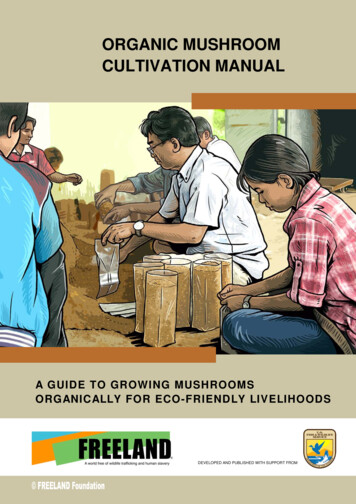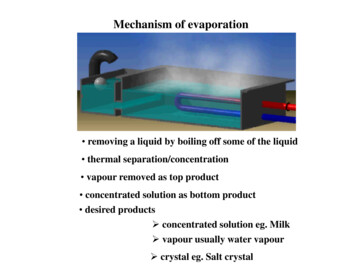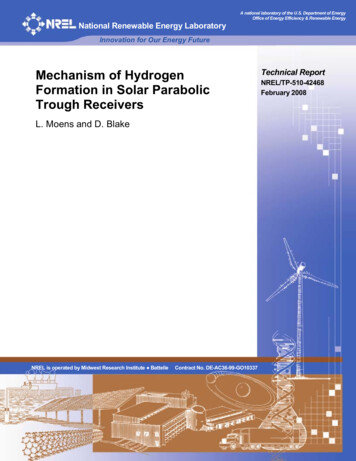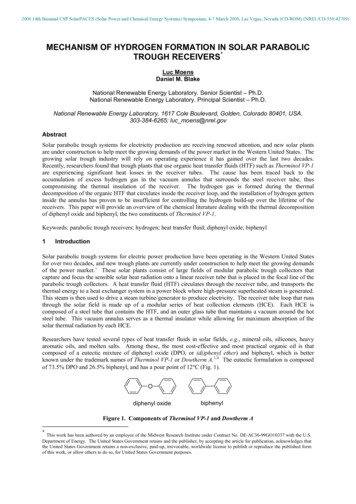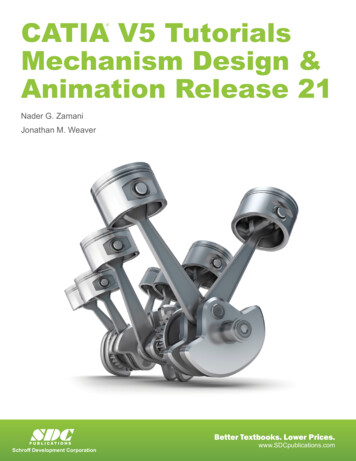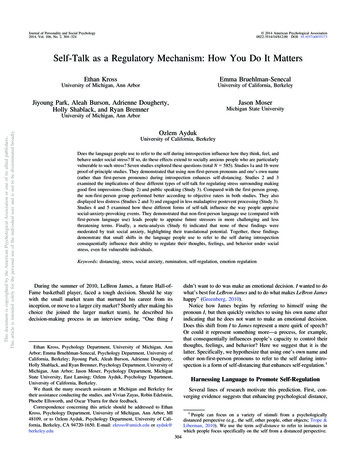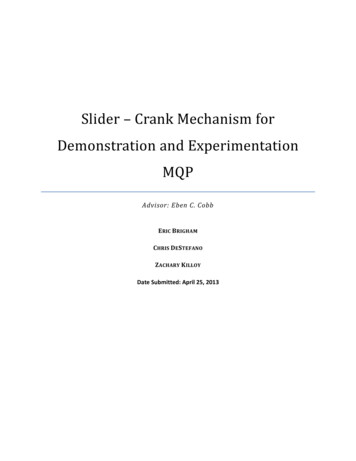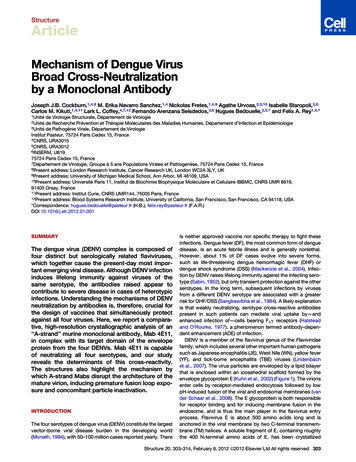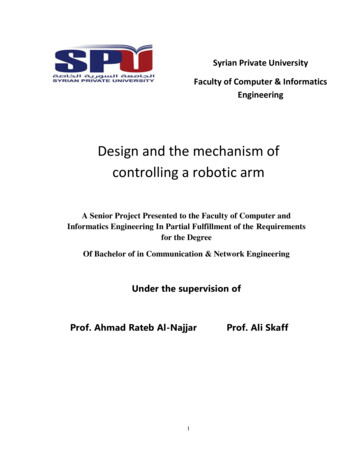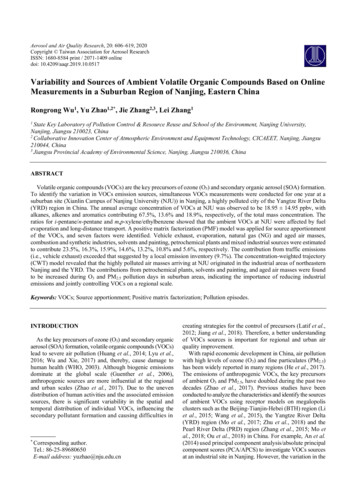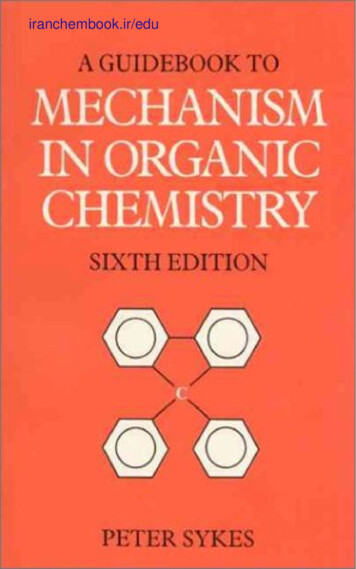
Transcription
iranchembook.ir/edu
iranchembook.ir/edu
iranchembook.ir/eduContents*PageForeword by fiofessor Lord Todd, O.M., P.P.R.S.preface to sixth editionStructure, reactivity, and mechanismixxi1Energetics, kinetics, and the investigation of mechanism33The strengths of acids and bases5377Nucleophilic substitution at a saturated carbon atomCarbocations, electron-deficient N and 0 atoms and theirreactions101Electrophilic and nucleophilic substitution in aromaticsystems130Electrophilic and nucleophilic addition to C C178Nucleophilic addition to C O203Elimination reactions246Carbanions and their reactionsRadicals and their reactionsSymmetry controlled reactionsLinear free energy relationshipsSelect bibliographyIndex* A detailed list of contents will be found at the beginning of each chapter.399
iranchembook.ir/eduForewordFifty years ago the student taking up organic chemistry-and I speakfrom experience-wa almost certain to be referred to one or other ofa few textbooks generally known by the name of their authors--e.g.Holleman, Bernthsen, Schrnidt, Karrer and Gattermann. On thesetexts successive generations of chemists were nurtured, and not in onecountry alone, for they were translated into several languages. These,the household names of fifty years ago, have for the most part gone. Inpast times of course the total number of books available was rathersmall and it is only in the last quarter of a century that we have seena veritable flood of organic chemical textbooks pouring into booksellers' lists. The increase in the number of texts may be in part due tothe rise in student numbers but the primary reason for it is the revolutionary impact of mechanistic studies on our approach to organicchemistry at the elementary level. With the plethora of books available, however, it is now much more difficult for an author to becomea household name wherever the subject is taught. Yet this has indeedhappened to Dr. Peter Sykes through his Guidebook to Mechanism inOrganic Chemistry.In the Foreword which I was privileged to write for the FirstEdition in 1961 I described not only my own view of what was happening in organic chemistry but also the type of approach to teaching itwhich was favoured by Dr. Sykes. Having known and watched himover many years first as student, then as colleague, and always asfriend, I was confident that he had written an excellent book which,in my view at least, would add new interest to the study of organicchemistry. But its success has far exceeded even my high expectationsand in its later editions it has been revised and refined without everlosing the cutting edge of the original.The present volume continues the tradition. Once again the recentliterature has been combed for new examples the better to exemplifyprinciples of reactions. Of particular interest is an admirable chapterdealing with reactions controlled by orbital symmetry. Until I read itI was not convinced that this very important new development in thetheory of organic reactions could be simply yet usefully communicatedto students at an elementary level. T o have succeeded in doing so onlyunderlines further Dr. Sykes' gifts as a teacher and writer and I am surethat this new edition of the Guidebook will more than equal the successof its predecessors.CambridgeTODD
iranchembook.ir/edupreface to sixth editionIt is now twenty-five years since this Guidebook first appeared and,hardly surprisingly, the current version is vastly different in bothcontent and physical appearance from that first offering of so longago. Over the years a real endeavour has been made to incorporatenew, and to delete old, material not to reflect current trends andfashions, but to encompass significant changes in our fundamentalunderstanding of organic chemistry; more particularly, to decidehow these changes can best be conveyed to a largely undergraduateaudience. At the same time care has been taken to retain theunderlying framework and structure of the book for the excellent,reason that this has been found to work well in practice.The current version incorporates no new chapter but a number ofnew topics have been introduced, e.g. ipso aromatic substitution; themechanistic borderline in nucleophilic substitution; more use ofactivation parameters, particularly in ester hydrolysis; Dimroth's E,parameter; correlation of spectroscopic data with Hammett's U,;13C n.m.r. in biogenesis, etc. The now outmoded term 'carboniumion' has been replaced throughout by 'carbocation', which has theadvantage of being the natural antithesis to carbanion, and avoidsthe rather dubious alternative of carbenium ion. Apart from thesemore obvious changes, the whole text has been gone through, lineby line, in an effort to remove ambiguities, to provide clearer, morecogent explanations, and more telling examples. The overall result,in garage parlance, has been a very thorough overhaul and extensivere-tune!It has always been my feeling that many textbooks fall short oftheir full potential because the author has never entirely made uphis or her mind whether the subject matter is addressed wholly tostudents or, in part at least, to their mentors; and the requirementsof the two are, after all, different. This new edition is directed, aswere its predecessors, unequivocally at the student; I trust thereforethat it will continue to prove helpful to chemistry students ingeneral, irrespective of the particular institution in which theyhappen to be studying.As always I am greatly indebted to many correspondents whohave pointed out errors, infelicities, and made suggestions forimprovements; wherever feasible these have been incorporated inthis revision. I should greatly appreciate similar kind assistance fromreaders in the future.
iranchembook.ir/eduxiiPreface to sixth editionFinally, acknowledgement is made to the copyright holders forpermission to reprint diagrams as follows: the American ChemicalSociety for Fig. 13.1 (Hammett, L. P. and Pfluger, H. L., J. Amer.Chem. Soc., 1933, 55, 4083), Fig. 13.2 (Hammett, L. P. and PflugerH. L., J. Amer. Chem. Soc., 1933, 55, 4086), Fig. 13.3 (Hammett,L. P., Chem. Rev., 1935, 17, 131), Fig. 13.4 (Taft, R. W. and Lewis,I. C., J. Amer. Chem. Soc., 1958,80,2437), Fig. 13.5 (Brown, H. C.and Okamoto, Y., J. Amer. Chem. Soc., 1957, 79, 1915), Fig. 13.6(Brown, H. C., Schleyer, P. von R. et al., J. Amer. Chem. Soc.,1970, 92, 5244), Fig. 13.8 (Hart, H. and Sedor, F. A., J. Amer.Chem. Soc., 1967,89, 2344); the Chemical Society and Professor J.A. Leisten for Fig. 13.7 (Leisten, J. A. and Kershaw, D. N., Proc.Chem. Soc., 1960, 84).SStructure, reactivity, and mechanismATOMIC ORBITALS,p. 1.HYBRIDISATION, p. 4.BONDING IN CARBON COMPOUNDS,P. 5:1.3.1 Carbon-carbon single bonds, p. 6; 1.3.2 Carbon-carbondouble bonds, p. 8; 1.3.3 Carbon-carbon triple bonds, p. 9; 1.3.4Carbon xygen and carbon-nitrogen bonds, p. 10; 1.3.5Conjugation, p. 11; 1.3.6 Benzene and aromaticity, p. 14; 1.3.7Conditions necessary for delocalisation, p. 18.THE BREAKING AND FORMING OF BONDS, P. 20.FACTORS INFLUENCING -ON-AVAILABILITY,P. 2 1:1.5.1 Inductive and field effects, p. 21; 1.5.2 Mesomeric(conjugative) effects, p. 23; 1.5.3 Time-variable effects, p. 24; 1.5.4Hyperconjugation, p. 25. R I mC m , p. 26.R E A G TWES, p. 28.R E A O NTYPES, p. 30.CambridgeSeptember 1985The chief advantage of a mechanistic approach, to the vast array ofdisparate information that makes up organic chemistry, is the way inwhich a relatively small number of guiding principles can be used, notonly to explain and interrelate existing facts, but to forecast the outcome of changing the conditions under which already known reactionsare carried out, and to foretell the products that may be expectedfrom new ones. It is the business of this chapter to outline some ofthese guiding principles, and to show how they work. As it is thecompounds of carbon with which we shall be dealing, somethingmust be said about the way in which carbon atoms can form bondswith other atoms, especially with other carbon atoms.1.1ATOMlC ORBlTALSThe carbon atom has, outside' its nucleus, six electrons which, on theBohr theory of atomic structure. were believed to be arranged inorbits at increasing distance from the nucleus. These orbits corres-
2iranchembook.ir/edulStructure, reactivity, and mechanismponded to gradually increasing levels of energy, that of lowest energy,the Is, accommodating two electrons, the next, the 2s, also accommodating two electrons, and the remaining two electrons of the carbonatom going into the 2p level, which is actually capable of accommodating a total of six electrons.The Heisenberg indeterminacy principle, and the wave-mechanicalview of the electron, have made it necessary to do away with anythingso precisely defined as actual orbits. Instead the wave-like electronsand the precise, classicalare now symbolised by wave functions,orbits of Bohr are superseded by three-dimensional atomic orbitalsof differing energy level. The size, shape and orientation of theseatomic orbitals-regions in which there is the greatest probability offinding an electron corresponding to a particular, quantised energyetc. Thelevel-are each delineated by a wave function,orbitals are indeed rather like three-dimensional electronic contourmaps, in which ' determines the relative probability of finding anelectron at a particular point in the orbital.The relative size of atomic orbitals, which is found to increase astheir energy level rises, is defined by the principal quantum number, n,their shape and spatial orientation (with respect to the nucleus andeach other) by the subsidiary quantum numbers, l and m, respectively.*Electrons in orbitals also have a further designation in terms of thespin quantum number, which can have the values or - . Onelimitation that theory imposes on such orbitals is that each mayaccommodate not more than two electrons, these electrons beingdistinguished from each other by having opposed (paired) spins.t Thisfollows from the Pauli exclusion principle, which states that no twoelectrons in any atom may have exactly the same set of quantumnumbers.It can be shown, from wave-mechanical calculations, that the 1sorbital (quantum numbers n 1 , l 0, m 0 , corresponding to theclassical K shell) is spherically symmetrical about the nucleus of theatom, and that the 2s orbital (quantum numbers n 2 , l 0, m 0 )is similarly spherically symmetrical, but at a greater distance from thenucleus; there is a region between the two latter orbitals where theprobability of finding an electron approaches zero (a spherical nodalsurface).As yet, this marks no radical departure from the classical pictureof orbits, but with the 2 p level (the continuation of the L shell) adifference becomes apparent. Theory now requires the existence ofthree 2p orbitals (quantum numbers n 2 , l 1 , with m 1,0, and , ,, ,, ,n can have values of 1,2.3. . . . l values of 0. 1.2,. . . , n - I , and m values of0, 1, 2 , . . ., l. We shall normally be concerned only with l values of 0 and I , thecorresponding orbitals being referred to (from spectroscopic terminology) as s and porbitals, respectively, e.g. Is, 2s, 2p orbitals, etc.t One electron with spin quantum number ),the other - .1.1 Atomic orbitals3s3}M shellP2s-Is-ISK shell2s- 1 , respectively), all of the same shape and energy level (orbitalshaving the same energy level are described as degenerate), but differingfrom each other in their spatial orientation. They are in fact arrangedmutually at right-angles along notional X, y and z axes and, therefore,designated as 2px, 2py and 2pl, respectively. Further, these three 2porbitals are found not to be spherically symmetrical, like the 1s and2s, but 'dumb-bell'shaped with a plane, in which there is zero probabilityof finding an electron (nodal plane), passing through the nucleus (atright-angles to the X, y and z axes, respectively), and so separating thetwo halves of each dumb-bell :l NodalYplane'l NodalYIThe six electrons of the carbon atom are then accommodated inatomic orbitals of increasing energy level until all are assigned (theaufbau, or build-up, principle). Thus two electrons, with paired spins,will go into the 1s orbital, a further two into the 2s orbital, but at the2p level the remaining two electrons could be accommodated either inthe same, e.g. 2px, or different, e.g. 2px and 2py, orbitals. Hund's rule,which states that two electrons will avoid occupying the same orbitalso long as there are other energetically equivalent, i.e. degenerate,orbitals still empty, will apply, and the electron configuration of carbonwill thus be ls22s22pj2pj,with the 2p, orbital remaining unoccupied.This represents the ground state of the free carbon atom in whichonly two unpaired electrons (in the 2px and 2p, orbitals) are available
4iranchembook.ir/edu1.3 Bonding in carbon compoundsStructure, reactivity, and mechanismfor the formation of bonds with other atoms, i.e. at first sight carbonmight appear to be only divalent.This, however, is contrary to experience, for though compounds areknown in which carbon is singly bonded to only two other atoms,e.g. CC], (p. 267), these are highly unstable: in the enormous majorityof its compounds carbon exhibits quadrivalency, e.g. CH,. This canbe achieved by uncoupling the 2s2 electron pair, and promoting oneof them to the vacant 2pz orbital. The carbon atom is then in a higherenergy (excited) state, ls22s'2pt2pf 2p,', but as it now has four unpairedelectrons it is able to form four, rather than only two, bonds withother atoms or groups. The large amount of energy produced byforming these two extra bonds considerably outweighs that required[ 406kJ (97 kcal) mol-'1 for the initial 2s' uncoupling, and 2s 2p,promotion.1.2 HYBRIDISATIONA carbon atom combining with four other atoms clearly does not usethe one 2s and the three 2p atomic orbitals that would now be available,for this would lead to the formation of three directed bonds, mutuallyat right angles (with the three 2p orbitals), and one different, nondirected bond (with the spherical 2s orbital). Whereas in fact, the fourC-H bonds in, for example, methane are known to be identical andsymmetrically (tetrahedrally) disposed at an angle of 109" 28' to eachother. This may be accounted for on the basis of redeploying the 2sand the three 2p atomic orbitals so as to yield four new (identical)orbitals, which are capable of forming stronger bonds (c p. 5). Thesenew orbitals are known as sp3 hybrid atomic -orbitals, and the processby which they are obtained as hybridisation:I1I1l5Similar, but different, redeployment is envisaged when a carbonatom combines with three other atoms, e.g. in ethene (ethylene) (p. 8):three sp2 hybrid atomic orbitals disposed at 120' to each other inthe same plane (plane trigonal hybridisation) are then employed. Finally,when carbon combines with two other atoms, e.g. in ethyne (acetylene)(p. 9): two spl hybrid atomic orbitals disposed at 180" to each other(digonal hybridisation) are employed. In each case the s orbital isalways involved as it is the one of lowest energy level.These are all valid ways of deploying one 2s and three 2p atomicorbitals-in the case of sp2 hybridisation there will be one unhybridisedp orbital also available (p. 8), and in the case of spl hybridisation therewill be two (p. 10). Other, equally valid, modes of hybridisation arealso possible in which the hybrid orbitals are not necessarily identicalwith each other, e.g. those used in CH2C12compared with the onesused in CC], and CH,. Hybridisation takes place so that the atomconcerned can form as strong bonds as possible, and so that theother atoms thus bonded (and the electron pairs constituting thebonds) are as far apart from each other as possible, i.e. so that thetotal intrinsic energy of the resultant compound is at a minimum.1.3 BONDING IN CARBON COMPOUNDSBond formation between two atoms is then envisaged as the progressiveoverlapping of an atomic orbital from each of the participatingatoms, the greater the overlap achieved (the overlap integral), thestronger the bond so formed. The relative overlapping powers ofatomic orbitals have been calculated as follows:S 1 00p 1.72sp' 1.93sp2 1.99sp3 2.002s PX2 PZsp' hybridsIt should, however, be emphasised, despite the diagram above, thathybridisation is an operation carried out not actually on orbitalsthemselves but on the mathematical functions that define them.It will thus be apparent why the use of hybrid orbitals, e.g. sp3 hybridorbitals in the combination of one carbon and four hydrogen atomsto form methane, results in the formation of stronger bonds.When the atoms have come sufficiently close together, it can beshown that their two atomic orbitals are replaced by two molecularorbitals, one being at a lower, and the other at a higher, energy levelthan the two original atomic orbitals. These two new molecularorbitals spread over both atoms and either may contain the twoelectrons (Fig. 1.1):
6iranchembook.ir/edu1.3.1 Carbon-carbon single bondsStructure, reactivity, and mechanismAnti-bonding (a*)molecular orbitalerIAtomic orbital A5IAtomic orbital BABonding (a)molecular orbitalFig 1.1The molecular orbital of lower energy is called the bondingorbital, and its occupancy results in the formation of a stable bondbetween the two atoms. In the above case, the pair of electrons constituting the bond tend to be concentrated between the two positivelycharged atomic nuclei, which can thus be thought of as being heldtogether by the negative charge between them. The molecular orbitalof higher energy is called the anti-bonding orbital; this correspondsto a state in which the internuclear space remains largely empty ofelectrons, and thus results in repulsion between the two positivelycharged atomic nuclei. The anti-bonding orbital remains empty in theground state of the molecule, and need not here be further consideredin the formation of stable bonds between atoms.If overlap of the two atomic orbitals has taken place along theirmajor axes, the resultant bonding molecular orbital is referred to as aa orbital,* and the bond formed as a a bond. The a molecular orbital,and the electrons occupying it, are found to be localised symmetricallyabout the internuclear axis of the atoms that are bonded to each other.Thus on combining with hydrogen, the four hybrid sp3 atomic orbitalsof carbon overlap with the 1s atomic orbitals of four hydrogen atomsto form four identical, strong a bonds, making angles of 109" 28' witheach other (the regular tetrahedral angle), in methane. A similar,exactly regular, tetrahedral structure will result with, for example,CCI,, but where the atoms bonded to carbon are not all the same,e.g. CH2C12, the spatial arrangement may depart slightly from theexactly symmetrical while remaining essentially tetrahedral (cf. p. 5).1.3.1 Carboltcarbon single bondsThe combination of two carbon atoms, for example in ethane, resultsfrom the axial overlap of two sp3 atomic orbitals, one from eachThe anti-bonding molecular orbital is referred to as a a* orbital.7carbon atom, to form a strong a bond between them. The carboncarbon bond length in saturated compounds is found to be prettyconstant4.154 nm (1.54 A). This refers, however, to a carbon-arbonsingle bond between sp3 hybridised carbons. A similar single bondbetween two sp2 hybridised carbons, CH-CH ,is found on averageto be about 0.147 nm (1-47A) in length, and one between two splhybridised carbons, -C-C-,about 0.138 nm (1.38A). This is notreally surprising, for an s orbital and any electrons in it are held closerto, and more tightly by, the nucleus than is a p orbital and any electronsin it. The same effect will be observed with hybrid orbitals as theirs component increases, and for two carbon atoms bonded to eachother the nuclei are drawn inexorably closer together on going fromWe have not, however, defined a unique structure for ethane; thea bond joining the two carbon atoms is symmetrical about a linejoining the two nuclei, and, theoretically, an infinite variety of differentstructures is still possible, defined by the position of the hydrogenson one carbon atom relative to the position of those on the other.The two extremes, of all the possible species, are known as the eclipsedand staggered forms :EclipsedStaggeredThe above quasi three-dimensional representations are known as'sawhorse' and Newman projections, respectively. The eclipsed andstaggered forms, and the infinite variety of possible structures lyingbetween them as extremes, are known as conformations of the ethanemolecule; conformations being defined as different arrangements ofthe same group of atoms that can be converted into one anotherwithout the breaking of any bonds.The staggered conformation is likely to be the more stable of thetwo as hydrogen atoms on one carbon are then as far away fromthose on the other as they can get (0.310 nm; 3.1 A), and anyso-called 'non-bonded' interaction between them is thus at a
8iranchembook.ir/eduStructure, reactivity, and mechanismminimum; whereas in the eclipsed conformation they are sufferingthe maximum of crowding [O-230 nm (2-3 A), slightly less than thesum of their van der Waals radii]. The long cherished principle offree rotation about a carbon-carbon single bond is not contravened,however, as it has been shown that the eclipsed and staggeredconformations differ by only l2kJ (3 kcal) mol-' in energy contentat 2S0, and this is small enough to allow their ready interconversionthrough the agency of ordinary thermal motions at roomtemperature-the rotation frequency at 25' being 1 0sec-'.' Thatsuch crowding can lead to a real restriction of rotation about acarbon-carbon single bond has been confirmed by the isolation oftwo forms of CHBr2CHBr2, though admittedly only at low temperatures where collisions between molecules do not provide enoughenergy to effect the interconversion.13.2 Carbon-carbon double bondsIn ethene each carbon atom is bonded to only three other atoms, twohydrogens and one carbon. Strong a bonds are formed with thesethree atoms by the use of three orbitals derived by hybridising the 2sand, this time, two only of the carbon atom's 2p atomic orbitals-anatom will normally only mobilise as many hybrid orbitals as it hasatoms or groups to form strong a bonds with. The resultant sp2 hybridorbitals all lie in the same plane, and are inclined at 120" to each other(plane trigonal orbitals). In forming the molecule of ethene, two of thesp2 orbitals of each carbon atom are seen as overlapping with the1s orbitals of two hydrogen atoms to form two strong a C-H bonds,while the third sp2 orbital of each carbon atom overlap axially to forma strong a C-C bond between them. It is found experimentally thatthe H-C-Hand H-C-Cbond angles are in fact 116-7Oand 121.6",respectively. The departure from 120" is hardly surprising seeing thatdifferent trios of atoms are involved.This then leaves, on each carbon atom, one unhybridised 2p atomicorbital at right angles to the plane containing the carbon and hydrogenatoms. When these two 2p orbitals become parallel to each otherthey can themselves overlap, resulting in the formation of a bondingmolecular orbital spreading over both carbon atoms and situatedabove and below the plane (i.e. it has a node in the plane of themolecule) containing the two carbon and four hydrogen atoms('-, indicates bonds to atoms lying behind the plane of the paper,and \ bonds to those lying in front of it):1.3.3 Carbon-carbon triple bonh9This new bonding molecular orbital is known as a a orbital,* and theelectrons that occupy it as a electrons. The new a bond that is thusformed has the effect of drawing the carbon atoms closer together,and the C C distance in ethene is found to be 0.133 nm (1.33 A),compared with a C-C distance of 0.154 nm (1.54 A) in ethane. Thelateral overlap of the p atomic orbitals that occurs in forming a abond is less effective than the axial overlap that occurs in forming aa bond, and the former is thus weaker than the latter. This is reflectedin the fact that the energy of a carbon-carbon double bond, thoughmore than that of a single bond is, indeed, less than twice as much.Thus the C-C bond energy in ethane is 347 kJ (83 kcal) mol- l, whilethat of C C in ethene is only 598 kJ (143 kcal) mol-l.The lateral overlap of the two 2p atomic orbitals, and hence thestrength of the a bond, will clearly be at a maximum when the twocarbon and four hydrogen atoms are exactly coplanar, for it is only inthis position that the p atomic orbitals are exactly parallel to eachother, and will thus be capable of maximum overlap. Any disturbance of this coplanar state, by twisting about the U bond joiningthe two carbon atoms, would lead to reduction in .rr overlapping,and hence a decrease in the strength of the .rr bond: it will thus beresisted. A theoretical justification is thus provided for the longobserved resistance to rotation about a carbon-carbon double bond.The distribution of the .rr electrons in two lobes, above and belowthe plane of the molecule, and extending beyond the carbon-carbonbond axis, means that a region of negative charge is effectivelywaiting there to welcome any electron-seeking reagents (e.g. oxidising agents); so that it comes as no surprise to realise that thecharacteristic reactions of a carbon-carbon double bond are predominantly with such reagents (cf. p. 178). Here the classical pictureof a double bond has been replaced by an alternative, in which thetwo bonds joining the carbon atoms, far from being identical,are considered to be different in nature, strength and position.1.3.3 C a r b o a r b o ntriple bondsIn ethyne each carbon atom is bonded to only two other atoms, onehydrogen and one carbon. Strong a bonds are formed with these twoatoms by the use of two hybrid orbitals derived by hybridising the 2sand, this time, one only of the carbon atom's 2p atomic orbitals. Theresultant digonal spl hybrid orbitals are CO-linear.Thus, in forming themolecule of ethyne, these hybrid orbitals are used to form strong Ubonds between each carbon atom and one hydrogen atom, andbetween the two carbon atoms themselves, resulting in a linear moleculeA n anti-bonding, n*, molecular orbital is also formed (cc p. 12)
iranchembook.ir/edu10Structure, reactivity, and mechanismhaving two unhybridised 2p atomic orbitals, at right angles to eachother, on each of the two carbon atoms. The atomic orbitals on onecarbon atom are parallel to those on the other, and can thus overlapwith each other resulting in the formation of two n bonds in planesat right angles to each other:The ethyne molecule is thus effectively sheathed in a cylinder ofnegative charge. The C E C bond energy is 812 kJ (194 kcal) mol- l, sothat the increment due to the third bond is less than that occurring ongoing from a single to a double bond. The C r C bond distance is0-120nm (1.204 so that the carbon atoms have been drawn stillfurther together, but here again the decrement on going C C - C F Cis smaller than that on going C-C C*.13.41.3.5 ConjugationIIThe C-C-0bond angle is found to be x120 , the C O bondlength, 0122 nm (1-22A), and the bond energy, 750 kJ (179 kcal) mol- l.The fact that this is very slightly greater than twice the C - 0 bondenergy, whereas the C C bond energy is markedly less than twicethat of C-C, may be due in part to the fact that the lone pairs onoxygen are further apart, and so more stable, in C O than in C - 0 ;there being no equivalent circumstance with carbon. The fact thatcarbon-xygen, unlike carbon-carbon, bonds are polar linkages alsoplays a part.A nitrogen atom, with the electron configuration ls22s22pt2p,t2p,',can also be looked upon as using hybrid orbitals in forming single,C-N, double, C N, and triple, C E N , bonds with carbon. In eachcase one such orbital is used to accommodate the nitrogen lone pairof electrons; in double and triple bond formation one and two n bonds,respectively, are also formed by lateral overlap of the unhybridised porbitals on nitrogen and carbon. Average bond lengths and bondenergies are single, 0.147 nm (1.47 A) and 305 kJ (73 kcal) mol- l,double, 0.129 nm (1.29 A) and 616 kJ (147 kcal) mol- l, and triple,0.1 16nm (1.16A) and 893 kJ (213 kcal)mol-l.Carborr-oxygen and carbon-nitrogen bondsAn oxygen atom has the electron configuration ls22s22p 2p 2p ,.andit too, on combining with other atoms, can be looked upon as utilisinghybrid orbitals so as to form the strongest possible bonds. Thus oncombining with the carbon atoms of two methyl groups, to formmethoxymethane (dimethyl ether), CH,-@-CH,,the oxygen atomcould use four sp3 hybrid orbitals: two to form U bonds by overlapwith an sp3 orbital of each of the two carbon atoms, and the othertwo to accommodate its two lone pairs of electrons. The C-0-Cbond angle is found to be 110 , the C - 0 bond length, 0.142 nm(1.42 A), and the bond energy, 360 kJ (86 kcal) mol- l.An oxygen atom can also form a double bond to carbon; thus inpropanone (acetone), Mezw.:,the oxygen atom could use three sp2hybrid orbitals: one to form a a bond by overlap with an sp2 orbitalof the carbon atom, and the other two to accommodate the two lonepairs of electrons. This leaves an unhybridised p orbital on bothoxygen and carbon, and these can overlap with each other laterally(c C*,p. 9) to form a n bond :When we come to consider molecules that contain more than onemultiple bond, e.g. dienes with two C C bonds, it is found thatcompounds in which the bonds are conjugated (alternating multipleand single; 1) are slightly more stable than those in which they areisolated (2) :
iranchembook.ir/edu12Conjugation is not of course confined to carbon-carbon multiplebonds.With both (la) and (2a) above, lateral overlap of the p atomicorbitals on adjacent carbon atoms could lead to the formation of twolocalised K bonds as shown, and the compounds would thus beexpected to resemble
a veritable flood of organic chemical textbooks pouring into book- sellers' lists. The increase in the number of texts may be in part due to the rise in student numbers but the primary reason for it is the revolu- tionary impact of mechanistic studies on o
